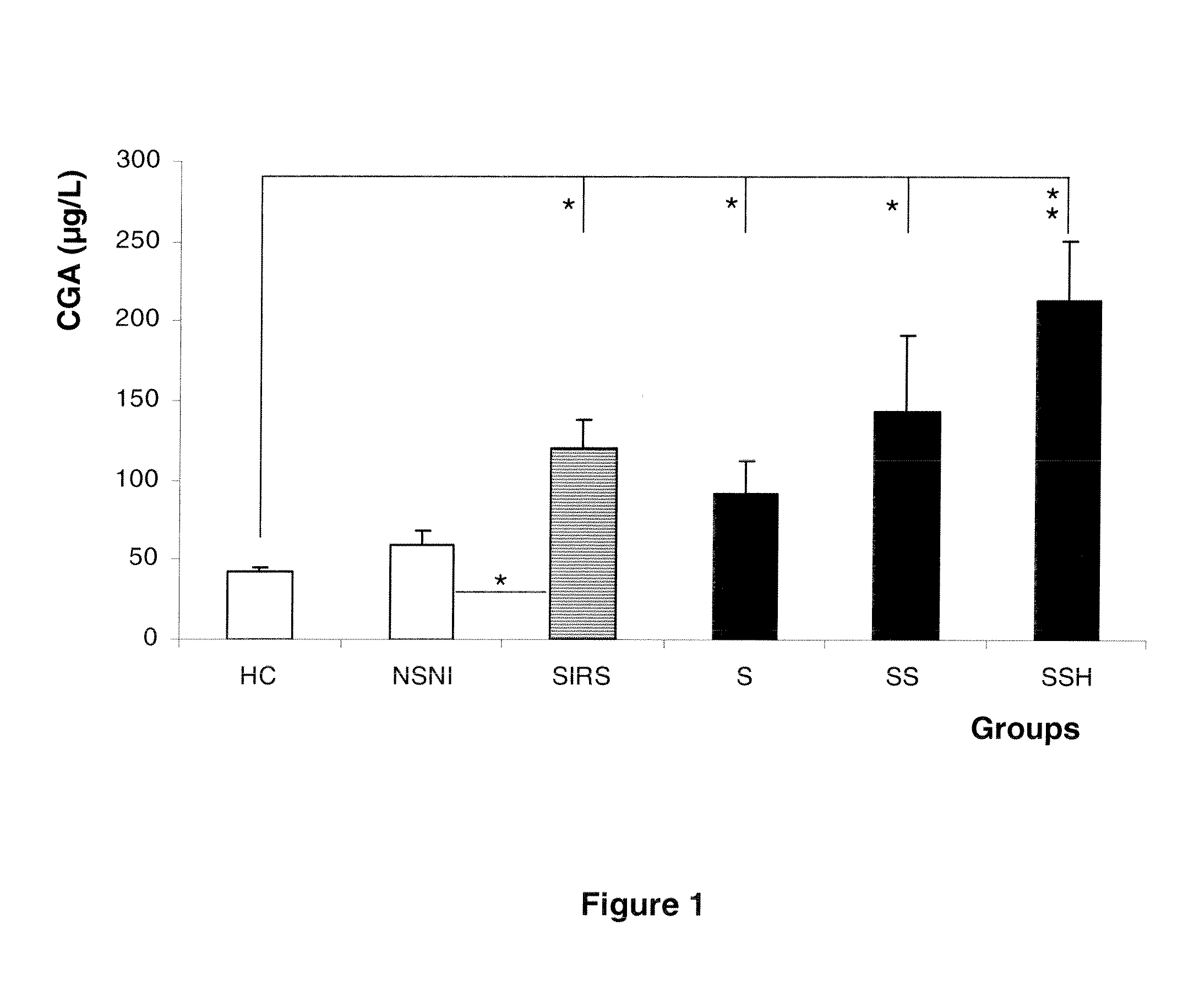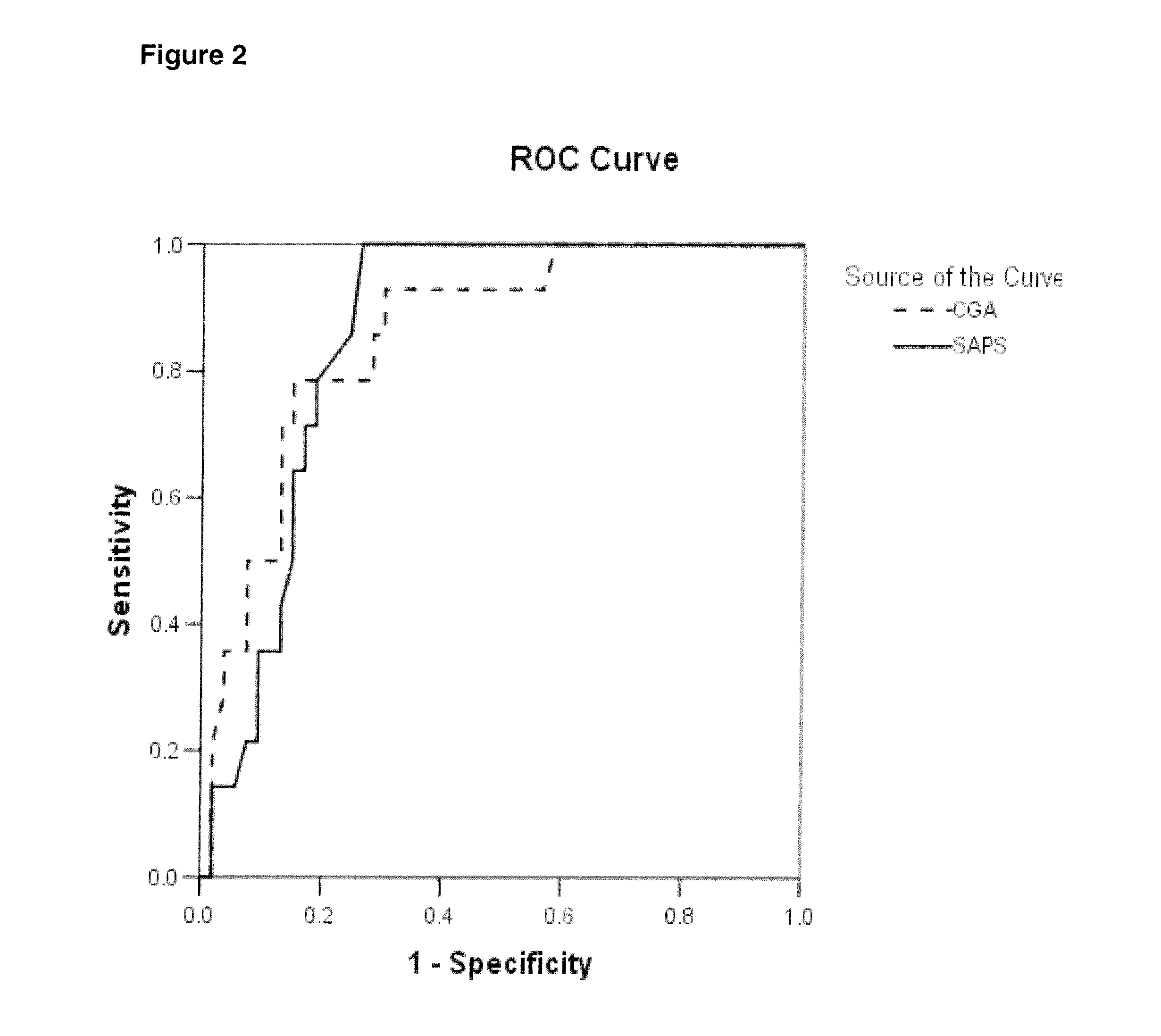Method for Predicting the Outcome of a Critically Ill Patient
a technology for critically ill patients and outcomes, applied in the field of critically ill patients' outcome prediction, can solve the problems of progressive decline of vital organ functions, high and short-term mortality rates, and insidious experiences
- Summary
- Abstract
- Description
- Claims
- Application Information
AI Technical Summary
Benefits of technology
Problems solved by technology
Method used
Image
Examples
example 1
Material and Methods
[0069]Study population: One hundred consecutive patients admitted between July and September 2006 in our intensive care unit were prospectively considered for inclusion. Fourteen healthy volunteers were recruited among staff as healthy controls (HC). Exclusion criteria comprised former chronic renal, hepatic or cardiac failure (Taupenot et al. N Engl J Med 2003; 348: 1134-49), ongoing steroids (Rozansky et al. J Clin Invest 1994; 94: 2357-68.), proton pump inhibitors (Giusti et al. Eur J Endocrinol 2004; 150: 299-303) and a medical history with neuroendocrine tumours (Berruti et al. Endocr Relat Cancer 2005; 12: 109-17). In addition, patients with recent (within 1 month) multiple stress, such as a surgical intervention were excluded.
[0070]Categorization of participants: Participants (n=114) were divided into six groups: healthy controls (HC), non septic non stressed patients (NSNI) that were comatose patients after self-poisoning requiring therefore transiently m...
example 2
Plasma Concentration of Chromogranin a at Admission: an Early Biomarker of Severity in Critically Ill Patients
Abstract
[0081]Aim. To determine evidence for a link between plasma concentration of CGA, biomarkers of inflammation and outcome in patients admitted with or without a Systemic Inflammatory Response Syndrome (SIRS).
[0082]Methods. At admission, we measured the plasma concentrations of CGA, procalcitonin and C-reactive protein, and we assessed the Simplified Acute Physiological Score (SAPS) in 53 patients.
[0083]Results. Plasma CGA concentrations were significantly increased in SIRS patients with a median value of 115 μg / L (68.0-202.8), when compared to healthy controls (p<0.001).
[0084]In cases where infection was associated with SIRS, patients had the highest increase in CGA with a median value of 138.5 μg / L (65-222.3) (p<0.001). CGA concentrations positively correlated with inflammation markers (procalcitonin, C-reactive protein), but also with SAPS. Receiver Operating Charact...
example 3
Prognostic Value of Chromogranin a at Admission in Critically Ill Patients: a Cohort Study in a Medical Intensive Care Unit
Abstract
[0101]Methods: We conducted a prospective study in such patients to measure serum procalcitonin (PCT), C-reactive protein (CRP) and CGA obtained at admission. Univariate and multivariate analyses were performed to identify the ability of these biomarkers to predict mortality.
[0102]Results: In 120 consecutive patients a positive correlation was found between CGA and CRP (r2=0.216, p=0.02) and PCT (r2=0.396, p2=0.438, p2=0.374, p2=0.352). In multivariate analysis, 3 independent factors were involved in death prediction: log-normalized CGA levels (hazard ratio (HR)=7.248, 95% confidence interval (CI) 3.004-17.487), SAPSII (HR=1.046, 95% CI 1.026-1.067) and cardiogenic shock (HR=3.920, 95% CI 1.731-8.880).
[0103]Conclusions: CGA is a strong and independent indicator of prognosis in non surgical critically ill patients.
PUM
 Login to View More
Login to View More Abstract
Description
Claims
Application Information
 Login to View More
Login to View More - R&D
- Intellectual Property
- Life Sciences
- Materials
- Tech Scout
- Unparalleled Data Quality
- Higher Quality Content
- 60% Fewer Hallucinations
Browse by: Latest US Patents, China's latest patents, Technical Efficacy Thesaurus, Application Domain, Technology Topic, Popular Technical Reports.
© 2025 PatSnap. All rights reserved.Legal|Privacy policy|Modern Slavery Act Transparency Statement|Sitemap|About US| Contact US: help@patsnap.com



